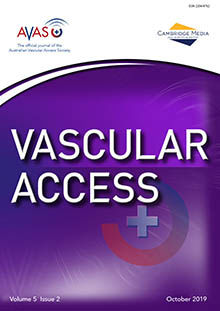Introduction Published guidelines recommend patients and carers are trained and meet competency in certain criteria of connecting and disconnecting procedures before discharge from hospital on home parenteral nutrition (HPN). Despite many HPN users requiring HPN indefinitely, Parenteral Nutrition Down Under Inc. (PNDU), the consumer support and advocacy organisation for HPN users and carers in Australia and New Zealand, was not aware of any retraining of HPN users unless the user had recurring central line-associated bloodstream infection (CLABSI).
Objectives To survey PNDU members on their experiences of formal retraining in HPN procedures, and to assess how members perform one aspect of these procedures – withdraw back (into syringe) – for comparison with the latest recommended protocols.
Methods An anonymous online questionnaire was circulated in November 2018 to all PNDU HPN users and carers in Australia and New Zealand, with an invitation to all active adult HPN users – or carers of active child/adult HPN users – to participate. Following screening and demographic questions, the survey had two parts. First, questions regarding the form of any initial training before hospital discharge, followed by questions regarding any experiences in formal retraining in HPN procedures, including extent, frequency and reason. Second, questions regarding one step of the connecting procedures – withdraw back (into syringe) – sought to identify responders’ specific protocols, and determine if this was taught during the initial HPN training.
Results There were 40 responders, representing 30 adult and 10 child HPN users. This represented 56.3% of active HPN users in PNDU, and 14.2% of the estimated 282 HPN users in Australia and New Zealand. A total of 32 (80.0%) responders had been on HPN for two or more years, receiving initial training before discharge. Just over half (57.9%) had received retraining, with most (81.0%) retraining prompted by a specific event, commonly related to a suspected or confirmed CLABSI, or change of medical equipment/item used to perform the procedure. Overall, 34 (85.0%) responders withdrew back into the syringe before connecting to parenteral nutrition (PN), 25 (73.5%) discarded the aspirate, and nine (26.5%) pushed the fluid back into the central line.
Conclusions Few HPN users receive regular retraining as part of HPN management. Beyond the written instructions given with initial HPN training, we recommend regular retraining and updating in protocols be included in HPN care to realise complication prevention benefits such as maintaining quality of life and reducing healthcare costs. Additionally, in view of technique variations, more research is needed to determine best practice for withdrawal of blood and, if required, how much drawback is sufficient and safe. These results should be included in HPN procedure guidelines.

